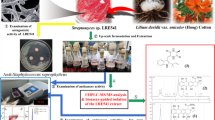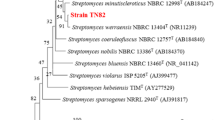Abstract
Actinomycetes are known to produce numerous secondary bioactive metabolites of pharmaceutical interest. The purpose of this study was to isolate, characterize, and investigate the antibacterial, antifungal, and anticancer activities of metabolites produced by Actinobacteria isolated from the rhizosphere of Paullinia cupana. The Actinobacteria was identified as Streptomyces hygroscopicus ACTMS-9H. Based on a bioguided study, the methanolic biomass extract obtained from submerged cultivation had the most potent antibacterial, antifungal, and cytotoxic activities. This extract was partitioned with n-hexane, ethyl acetate, and 2-butanol. Elaiophylin was isolated from the methanolic biomass extract, and its molecular formula was determined (C54H88O18) based on 1H and 13C NMR, IR and MS analyses. The 2-butanol phase was fractionated into four fractions (EB1, EB2A, EB2B, and EB3M). Chemical prospecting indicated the presence of alkaloids, saponins, and reducing sugars in the methanolic extract and 2-butanol phase. The elaiophylin displayed anticancer activity in HEp-2 and HL-60 cells with an IC50 of 1 μg/mL. The EB1 fraction was selectively toxic to HL-60 cells with IC50 of 9 ng/mL. Bioautography showed that the EB1 fraction contained an alkaloid with antibacterial and antifungal activities (MIC values ≤1.9 and <3.9 μg/mL, respectively). In conclusion, the EB1 fraction and elaiophylin of S. hygroscopicus have potent antimicrobial, antifungal, and anticancer activities.




Similar content being viewed by others
References
Alley MC, Scudiere DA, Monks A, Hursey M, Czerwinski MJ, Fine DL, Abbott BJ, Mayo JG, Shoemaker RH, Boyd MR (1998) Feasibility of drug screening with panels of human tumor cell lines using a microculture tetrazolium assay. Cancer Res 48:589–601
Ângelo PCS, Nunes-Silva CG, BrÍgido MM, Azevedo JSN, Assunção EN, Sousa ARB, Patrício FJB, Rego MM, Peixoto JCC, Oliveira-Jr WP, Freitas DV, Almeida ERP, Viana AMHA, Souza AFPN, Andrade EV, Acosta POA, Batista JS, Walter MEMT, Leomil L, Anjos DAS, Coimbra RCM, Barbosa MHN, Honda E, Pereira SS, Silva A, Pereira JO, Silva ML, Marins M, Holanda FJ, Abreu RMM, Pando SC, Gonçalves JFC, Carvalho ML, Leal-Mesquita ERRBP, Silveira MA, Batista WC, Atroch AL, França SC, Porto JIR, Schneider MPC, Astolfi-Filho S (2008) Guarana (Paullinia cupana var. sorbilis), an anciently consumed stimulant from the Amazon rain forest: the seeded-fruit transcriptome. Plant Cell Rep. doi:10.1007/s00299-007-0456-y
Anzai K, Ohno M, Nakashima T, Kuwahara N, Suzuki R, Tamura T, Komaki H, Miyadoh S, Harayama S, Ando K (2008) Taxonomic distribution of Streptomyces species capable of producing bioactive compounds among strains preserved at NITE/NBRC. Appl Microbiol Biotechnol. doi:10.1007/s00253-008-1510-6
Baker DD, Chu M, Oza U, Rajgarhia V (2007) The value of natural products to future pharmaceutical discovery. Nat Prod Rep. doi:10.1039/b602241n
Ballav S, Dastager SG, Kerkar S (2012) Biotechnological significance of actinobacterial research in India. Recent Res Sci Technol. doi:10.13140/2.1.2021.7285
Benizri E, Baudoin E, Guckert A (2001) Root colonization by inoculated plant growth-promoting rhizobacteria. Biocontrol Sci Tech. doi:10.1080/09583150120076120
Choma IM, Grzelak EM (2011) Bioautography detection in thin-layer chromatography. J Chromatogr A. doi:10.1016/j.chroma.2010.12.069
CLSI (2008) Clinical and Laboratory Standards Institute: reference method for broth dilution antifungal susceptibility testing of yeasts and filamentous fungi. Approved standard: M27-A3 e M38-A2. Wayne (PA): CLSI, 2008
CLSI (2010) Clinical and Laboratory Standards Institute: performance standards for antimicrobial susceptibility testing. Twentieth informational supplement: M100-S20 e M100-S20-U. Wayne (PA): CLSI, 2010
Cragg GM, Newman DJ (2000) Antineoplastic agents from natural sources: achievements and future directions. Expert Opin Inv Drugs. doi:10.1517/13543784.9.12.2783
Demain AL (1999) Pharmaceutically active secondary metabolites of microorganisms. Appl Microbiol Biotechnol. doi:10.1007/s002530051546
Demain AL, Sanchez S (2009) Microbial drug discovery: 80 years of progress. J Antibiot. doi:10.1038/ja.2008.16
Doseung L, Woo JK, Kim D, Kim M, Cho SK, Kim JH, Park SP, Lee HY, Riu KZ, Lee DS (2011) Antiviral activity of methylelaiophylin, an α-glucosidase inhibitor. J Microbiol Biotechnol. doi:10.4014/jmb.1011.11002
Elliah P, Ramana T, Bapi Raju KVVS, Sujatha P, Uma Sankar AM (2004) Investigation on marine actinomycetes from Bay of Bengal near Karnataka coast of Andra Pradesh. Asian J Microbiol Biotechnol Environ Sci 6:53–56
Fang A, Wong GW, Demain AL (2000) Enhancement of the antifungal activity of rapamycin by the coproduced elaiophylin and nigericin. J Antibiot 53:158–162
Flardh K, Buttner MJ (2009) Streptomyces morphogenetics: dissecting differentiation in a filamentous bacterium. Nat Rev Microbiol. doi:10.1038/nrmicro1968
Furumai T, Yamakawa T, Yoshida R, Igarashi Y (2003) Clethramycin, a new inhibitor of pollen tube growth with antifungal activity from Streptomyces hygroscopicus TP-A0623. J Antibiot. doi:10.7164/antibiotics.56.700
Gesheva V (2009) Optimization of the production medium for biosynthesis of antifungal antibiotic Ak-111-81 by phosphate-deregulated mutant of Streptomyces hygroscopicus. Appl Microbiol Biotechnol. doi:10.1007/s12010-009-8629-5
Harborne JB (1998) Phytochemical methods: a guide to modern techniques of plant analysis. Chapman and Hall, New York
Haydock SF, Mironenko T, Ghoorahoo FI, Leadlay PF (2004) The putative elaiophylin biosynthetic gene cluster in Streptomyces sp. DSM4137 is adjacent to genes encoding adenosylcobalamin-dependent methylmalonyl CoA mutase and to genes for synthesis of cobalamin. J Biotechnol. doi:10.1016/j.jbiotec.2004.03.022
He H, Williamson RT, Shen B, Graziani EI, Yang HY, Sakya SM, Petersen PJ, Carter GT (2002) Mannopeptimycins, novel antibacterial glycopeptides from Streptomyces hygroscopicus, LL-AC98. J Am Chem Soc. doi:10.1021/ja020257s
Igarashi Y, Miura SS, Fujita T, Furumai T (2006) Pterocidin, a cytotoxic compound from the endophytic Streptomyces hygroscopicus. J Antibiot. doi:10.1038/ja.2006.28
Kumar PS, Raj JP, Duraipandiyan V, Ignacimuthu S (2012) Antibacterial activity of some actinomycetes from Tamil Nadu, India. Asian Pac J Trop Biomed. doi:10.1016/S2221-1691(13)60003-9
Kuri CMB (2008) The guarana industry in Brazil. Interbus Econ Res J. doi:10.19030/iber.v7i5.3258
Lee SY, Kim MS, Kim HS, Kim YH, Hong SD, Lee JJ (1996) Structure determination and biological activities of elaiophylin produced by Streptomyces sp. MCY-846. J Microbiol Biotechnol 6:245–249
Lee SY, Kim HS, Kim YH, Kim SB, Han SB, Kim HM, Hong SD, Lee JJ (1997) Immunosupressive activity of elaiophylins. J Microbiol Biotechnol 7:272–277
Li S, Wu L, Chen F, Wang H, Sun G, Wang Y (2011) Rapid identification of elaiophylin from Streptomyces hygroscopicus 17997, a geldanamycin producer. J Microbiol Biotechnol. doi:10.4014/jmb.1011.11002
Newman DJ, Cragg GM (2004) Marine natural products and related compounds in clinical and advanced preclinical trials. J Nat Prod. doi:10.1021/np040031y
Newman DJ, Cragg GM, Snader KM (2000) The influence of natural products upon drug discovery. Nat Prod Rep. doi:10.1039/A902202C
Newman DJ, Cragg GM, Snader KM (2003) Natural products as sources of new drugs over the period 1981-2002. J Nat Prod. doi:10.1021/np030096l
Prapagdee B, Kuekulvong C, Mongkolsuk S (2008) Antifungal potential of extracellular metabolites produced by Streptomyces hygroscopicus against phytopathogenic fungi. Int J Biol Sci. doi:10.7150/ijbs.4.330
Puder C, Krastel P, Zeeck A (2000) Streptazones A, B1, B2, C, and D: new piperidine alkaloids from Streptomycetes. J Nat Prod. doi:10.1021/np0001373
Raja A, Prabakarana P (2011) Actinomycetes and drug-an overview. Am J Drug Dis Dev. doi:10.3923/ajdd.2011.75.84
Rajeswari P, Jose PA, Amiya R, Jebakumar SRD (2015) Characterization of saltern based Streptomyces sp. and statistical media optimization for its improved antibacterial activity. Front Microbiol. doi:10.3389/fmicb.2014.00753
Robinson T, Singh D, Nigam P (2001) Solid-state fermentation: a promising microbial technology for secondary metabolite production. Appl Microbiol Biot. doi:10.1007/s002530000565
Rong X, Huang Y (2012) Taxonomic evaluation of the Streptomyces hygroscopicus clade using multilocus sequence analysis and DNA–DNA hybridization, validating the MLSA scheme for systematics of the whole genus. Syst App Microbiol. doi:10.1016/j.syapm.2011.10.004
Scorzoni L, Benaducci T, Almeida AMF, Silva DHS, Bolzani VS, Gianinni MJSM (2007) The use of standard methodology for determination of antifungal activity of natural products against medical yeasts Candida sp. and Cryptococcus sp. Braz J Microbiol. doi:10.1590/S1517-83822007000300001
Selvameenal L, Radhakrishnan M, Balagurunathan R (2009) Antibiotic pigment from desert soil actinomycetes; biological activity, purification and chemical screening. Indian J Pharm Sci. doi:10.4103/0250-474X.58174
Shirling EB, Gottlieb D (1966) Methods for characterization of Streptomyces species. Int J Syst Bacteriol. doi:10.1099/00207713-16-3-313
Singh LS, Sharma H, Talukdar NC (2014) Production of potent antimicrobial agent by actinomycete, Streptomyces sannanensis strain SU118 isolated from phoomdi in Loktak Lake of Manipur, India. BMC Microbiol. doi:10.1186/s12866-014-0278-3
Solecka J, Zajko J, Postek M, Rajnisz A (2012) Biologically active secondary metabolites from Actinomycetes. Cent Eur J Biol. doi:10.2478/s11535-012-0036-1
Stackebrandt E, Rainey FA, Ward-Rainey N (1997) Proposal for a new hierarchic classification system, Actinobacteria class nov. Int J Syst Bacteriol. doi:10.1099/00207713-47-2-479
Staneck J, Roberts GD (1974) Simplified approach to identification of aerobic actinomycetes by thin-layer chromatography. Appl Microbiol 28(2):226–231
Subramani R, Aalbersberg W (2012) Marine actinomycetes: an ongoing source of novel bioactive metabolites. Microbiol Res. doi:10.1016/j.micres.2012.06.005
Thomas AT, Rao JV, Subrahmanyam VM, Chandrashekhar HR, Maliyakkal N, Kisan TK, Joseph A, Udupa N (2011) In vitro anticancer activity of microbial isolates from diverse habitats. Braz J Pharm Sci. doi:10.1590/S1984-82502011000200009
Weisburg WG, Barns SM, Pelletier DA, Gene-Trak DJL (1991) 16s ribosomal DNA amplification for phylogenetic study. J Bacteriol doi: 0021-9193/91/020697-07$02.00/0
Williams ST, Sharp ME, Holt JG (1989) Bergey’s manual of systematic bacteriology. In: Williams and Wilkins, 1st ed., vol. 4, Baltimore, pp 2492–2504
Wu C, Tan Y, Gan M, Wang Y, Guan Y, Hu X, Zhou H, Shang X, You X, Yang Z, Xiao C (2013) Identification of elaiophylin derivatives from the marine-derived actinomycete Streptomyces sp. 7-145 using PCR-based screening. J Nat Prod. doi:10.1021/np4006794
Zgurskaya HI, Nikaido H (2000) Multidrug resistance mechanisms: drug efflux across two membranes. Mol Microbiol. doi:10.1046/j.1365-2958.2000.01926.x2000;37(2):219-25
Zhang H, Sun GZ, Li X, Pan HY, Zhang YS (2010) A new geldanamycin analogue from Streptomyces hygroscopicus. Molecules. doi:10.3390/molecules15031161
Zhang N, Sun C, Song Z, Guo H, Zhang B, Qiu N, Liu X (2011) Isolation, purification and characterization of antifungal substances from Streptomyces hygroscopicus BS-112. Acta Microbiol Sin 51(2):224–232
Zhao X, Fang Y, Yang Y, Qin Y, Wu P, Wang T, Lai H, Meng L, Wang D, Zheng Z, Lu X, Zhang H, Gao Q, Zhou J, Ma D (2015) Elaiophylin, a novel autophagy inhibitor, exerts antitumor activity as a single agent in ovarian cancer cells. Autophagy. doi:10.1080/15548627.2015.1017185
Acknowledgments
The authors thank the Coordenação de Aperfeiçoamento de Pessoal de Nível Superior (CAPES) and Fundação de Amparo a Ciência e Tecnologia de Pernambuco (FACEPE) for financial support. The authors thank CETENE for the use of the Scanning Electron Microscopy. We are grateful to Maria D. Rodrigues for the technical assistance. This manuscript was edited for the English language by American Journal Experts (certificate verification key: 93F3-2B7F-4692-D4CA-B62F).
Author information
Authors and Affiliations
Corresponding author
Ethics declarations
Conflict of interest
The authors declare that they have no conflicts of interest.
Ethical approval
This article does not contain any studies with human participants performed by any of the authors.
Electronic supplementary material
ESM 1
(PDF 723 kb)
Rights and permissions
About this article
Cite this article
Lima, S.M.A., Melo, J.G.S., Militão, G.C.G. et al. Characterization of the biochemical, physiological, and medicinal properties of Streptomyces hygroscopicus ACTMS-9H isolated from the Amazon (Brazil). Appl Microbiol Biotechnol 101, 711–723 (2017). https://doi.org/10.1007/s00253-016-7886-9
Received:
Revised:
Accepted:
Published:
Issue Date:
DOI: https://doi.org/10.1007/s00253-016-7886-9




